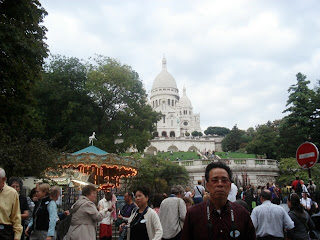Tour 4 The End: Paris, France
Transferring to Paris after our 6:30 a.m. breakfast via the exciting high-speed TVG train with travelling speeds of 320 km/h. Not exactly, I felt it's more like 70 with stops in between, towns of Bordeaux and Poitier. The high-speed train system links more than 200 destinations in France, making travel across the country a much more comfortable and convenient ride. Tour guide Isabella said it took 2 days from Lourdes to Paris before TVG.
This reminds me of scenes from George Simenon's Maigret, French detective
Video: Lourdes to Paris via TVG Train http://youtu.be/465zs6R-ld8
Arriving in Paris around 2:00 p.m. or so, six hours later. Then we hopped aboard our bus and drove to the Basilica of Sacred Heart, or Sacre Coeur. The impressive structure is located at the highest point in Montmartre, offering a spectacular view of Paris, and is home to a religious relic that is believe by some to be Christ's Sacred Heart.
On the way to Sacre Coeur
We went down the Basilica to a dark and musty underground chapel and celebrated Mass with Fr. Paul and Fr. Mel, two Franciscan priests from Lafayette, Indiana, However, Lucy, one of the pilgrims found where the light switch and turned it on.
The steps of Sacre Coeur were very dirty -- empty water bottle, wrapping papers. leftover food and cigarette butts. Ugly! Somebody please clean the place!
Fun ride at Montmartre Funiculaire (cable car)
The next day, after exploring the Louvre the whole morning, we had a private afternoon Mass at the Shrine of Miraculous Medal where, in 1830, three apparitions of the Virgin Mary appeared to a young nun (who, in 1947, was canonized and became St. Catherine de Laboure). In those visions, the Virgin Mary gave specific instructions for designing what would become the Medal of Immaculate Conception, or "Miraculous Medal."
Video
The incorruptible body of St. Catherine de Laboure
We made a short visit at St. Vincent de Paul Church. St. Vincent de Paul was born in France in 1580. While sailing from Marseilles, he was captured by Turkish pirates and taken to Tunisia where he was sold as a slave. He escaped after two years, and returned to France where he worked as a teacher to a wealthy family. He was ordained in 1600 and the young priest began administering to convicts in French jails, bringing them food and health care. He eventually built a hospital and hospice for the elderly. The French king appointed him royal almoner. Vincent was encouraged by others to start a religious institute of priests, the Congregation of the Mission (the Vincentians), to work with the poor in rural areas. With St. Louise de Marillac, he established the Daughters of Charity and Ladies of Charity to go and serve the poor. He and his missionaries worked among the slaves along western Africa's Barbary Coast (modern-day Morocco, Algeria, Tunisia and Libya) ransoming up to 1,200 galley slaves.
Vincent died in 1660. He was named patron of all charitable institutions by Pope Leo XIII. His feast is celebrated on September 27.
The preserved body of St. Vincent de Paul
Published 10/26/09 lib's labyrinth blogspot
Blog Page: ALT Travel: Paris





















No comments:
Post a Comment